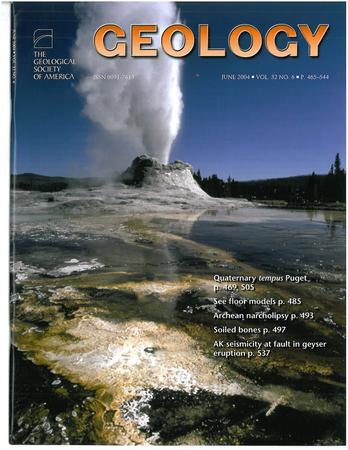陆地岩石风化后二氧化碳、钙和镁的命运
IF 4.6
1区 地球科学
Q1 GEOLOGY
引用次数: 0
摘要
在地质时间尺度上,硅酸盐-碳酸盐循环控制大气CO2浓度,调节地球气候。硅酸盐矿物受CO2的化学风化作用,导致阳离子释放,CO2中和为HCO3−或CO32−。一旦水过饱和,预计会有碳酸钙和碳酸镁矿物的沉淀。然而,量化所需的过饱和程度,特别是mg -碳酸盐,仍然具有挑战性。在这里,我们提供了一个来自加拿大不列颠哥伦比亚省中央高原的854个水样的数据库,代表了广泛的盐度,包括Na - (SO4) - HCO3 - CO3和Mg- Na - SO4高盐湖,以确定Ca-和Mg-碳酸盐岩形成的地球化学阈值。对于以hco3为主的水体,数据显示碳酸钙的最大碱度阈值为~ 5 mEq/kg,碳酸镁的最大碱度阈值为~ 40 mEq/kg。Ca−CO32−和Mg−CO32−活性图表明,碳酸钙和碳酸镁的最大饱和阈值适用于hco3为主、so4为主和富含co2的水体。这些地球化学阈值可用于优化地球化学二氧化碳去除(geoCDR)技术,如增强岩石风化,因为HCO3−的CDR效率高达碳酸盐矿物的两倍。本文章由计算机程序翻译,如有差异,请以英文原文为准。
The fate of CO2, Ca, and Mg after terrestrial rock weathering
The silicate−carbonate cycle controls atmospheric CO2 concentrations and moderates Earth’s climate over geologic time scales. Chemical weathering of silicate minerals by CO2 results in the release of cations and the neutralization of CO2 to HCO3− or CO32−. The precipitation of Ca- and Mg-carbonate minerals is expected once waters are supersaturated. However, quantifying the magnitude of supersaturation required, particularly for Mg-carbonates, has remained challenging. Here we present a database of 854 water samples from the Central Plateau, British Columbia, Canada, representing a wide range of salinities, including both Na−(SO4)−HCO3−CO3 and Mg−Na−SO4 hypersaline lakes, to determine the geochemical thresholds for Ca- and Mg-carbonate formation. For HCO3-dominated waters, the data indicate maximum alkalinity thresholds of ∼5 mEq/kg for Ca-carbonates and ∼40 mEq/kg for Mg-carbonates. Activity plots of Ca−CO32− and Mg−CO32− suggest that maximum saturation thresholds for both Ca-carbonates and Mg-carbonates are applicable to HCO3-dominated, SO4-dominated, and CO2-rich waters. These geochemical thresholds may be used to optimize geochemical carbon dioxide removal (geoCDR) technologies, such as enhanced rock weathering, as HCO3− has up to double the CDR efficiency of carbonate minerals.
求助全文
通过发布文献求助,成功后即可免费获取论文全文。
去求助
来源期刊

Geology
地学-地质学
CiteScore
10.00
自引率
3.40%
发文量
228
审稿时长
6.2 months
期刊介绍:
Published since 1973, Geology features rapid publication of about 23 refereed short (four-page) papers each month. Articles cover all earth-science disciplines and include new investigations and provocative topics. Professional geologists and university-level students in the earth sciences use this widely read journal to keep up with scientific research trends. The online forum section facilitates author-reader dialog. Includes color and occasional large-format illustrations on oversized loose inserts.
 求助内容:
求助内容: 应助结果提醒方式:
应助结果提醒方式:


